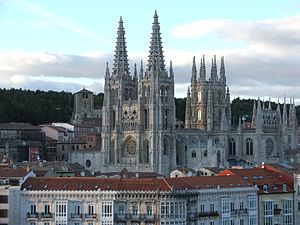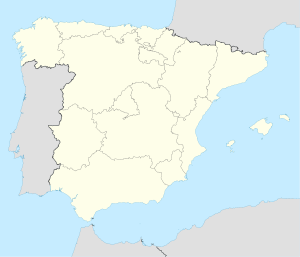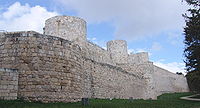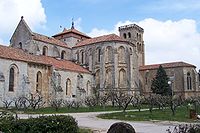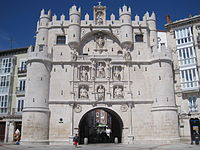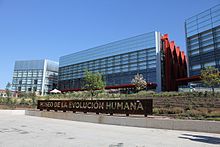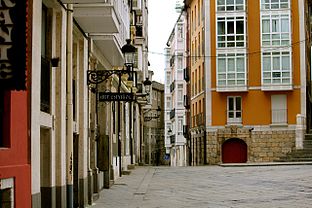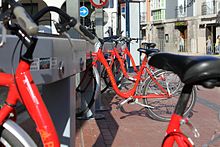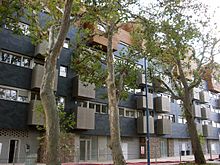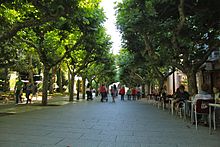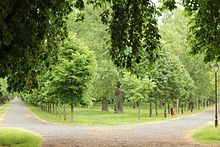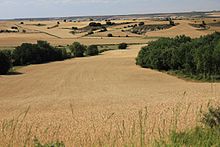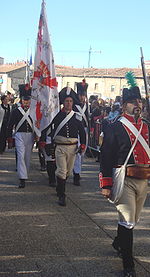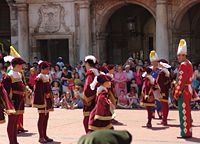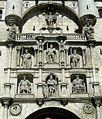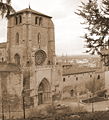- Burgos
-
For other meanings, see Burgos (disambiguation).
Burgos — City — 
Flag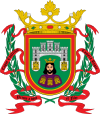
LogoLocation in Spain Coordinates: 42°21′N 3°42′W / 42.35°N 3.7°WCoordinates: 42°21′N 3°42′W / 42.35°N 3.7°W Country  Spain
SpainAutonomous community  Castile and León
Castile and LeónProvince Burgos Government – Mayor Javier Lacalle (Partido Popular) Area – Total 108 km2 (41.7 sq mi) Elevation 856 m (2,808 ft) Population (2010) – Total 178,574 Distances 122 km to Valladolid
244 km to MadridRivers Arlanzón, Vena, Pico, Cardeñadijo Demonym Burgalés/Burgalesa Website www.aytoburgos.es Burgos (Spanish pronunciation: [ˈburɣos], UK /ˈbʊərɡɒs/, US /ˈbʊərɡoʊs/) is a city of northern Spain, historic capital of Castile. It is situated at the edge of the central plateau, with about 178,966 inhabitants in the city proper and another 20,000 in its suburbs. It is the capital of the province of Burgos, in the autonomous community of Castile and León. The Burgos Laws or Leyes de Burgos first governing the behaviour of Spaniards towards natives of the Americas were promulgated there in 1512.
The city forms the principal crossway of north Spain, remarked by the Camino de Santiago, which goes throughout all the city, parallel to the Arlanzón river.
It has a wide number of historic landmarks, set apart specially by the Cathedral of Burgos, Las Huelgas Reales Monastery and the Cartuja of Miraflores.
The Museum of Human Evolution was opened in 2010, unique in its kind across the world and projected to become one of the top 10 visited museums in Spain.
Contents
History
Early humans occupied sites around Burgos as early as 800,000 years ago. When the Romans took possession of what is now the province of Burgos, the site had been a Celtiberian city. In Roman times, it belonged to Hispania Citerior ("Hither Spain") and then to Hispania Tarraconensis. In the 5th century, the Visigoths drove back the Suebi, then the Arabs occupied almost all of Castile in the 8th century, though only for a brief period, and left little if any trace of their occupation. Alfonso III the Great, king of León reconquered it about the middle of the 9th century, and built several castles for the defence of Christendom, which was then extended through the reconquest of lost territory. The region came to be known as Castile (Latin castella), i.e. "land of castles".
Burgos was founded in 884 as an outpost of this expanding Christian frontier,[1] when Diego Rodríguez "Porcelos", count of Castile, governed this territory with orders to promote the increase of the Christian population; with this end in view he gathered the inhabitants of the surrounding country into one fortified village, whose Visigothic name of Burgos signified consolidated walled villages (Gothic baurgs).[2] The city began to be called Caput Castellae ("Cabeza de Castilla" or "Head of Castile"). The county (condado) of Burgos, subject to the Kings of León, continued to be governed by counts and was gradually extended; one of these counts, Fernán González, established his independence.[3]
In the 11th century, the city became the see of a Catholic bishop and the capital of the Kingdom of Castile. Burgos was a major stop for pilgrims on their way to Santiago de Compostela[4] and a centre of trade between the Bay of Biscay and the south, which attracted an unusually large foreign merchant population, who became part of the city oligarchy and excluded other foreigners.[5] Throughout the 13th and 14th centuries, Burgos was a favourite seat of the kings of León and Castile and a favoured burial site. The consejo or urban commune of Burgos was firmly in the hands of an oligarchic class of caballeros villanos, the "peasant knights" of Burgos, who provided the monarchs with a mounted contingent: in 1255 and 1266 royal charters granted to those citizens of Burgos who owned horses and could arm themselves relief from taxes, provided that they continue to live within the city walls.[6] The merchant oligarchy succeeded the cathedral chapter as the major purchasers of land after 1250; they carried on their mercantile business in common with municipal or royal functions and sent their sons to England and Flanders to gain experience in overseas trade. A few families within the hermandades or confraternities like the Sarracín and Bonifaz succeeded in monopolising the post of alcalde, or mayor; a special court, the alcalde del rey was first mentioned at Burgos in 1281.[7] By the reign of Alfonso X, the exemption of the non-noble knights and religious corporations, combined with exorbitant gifts and grants to monasteries and private individuals, placed great stress on the economic well-being of the realm.
Abbey of Santa María la Real de Las Huelgas, was founded in 1180.
In the century following the conquest of Seville (1248), Burgos became a testing-ground for royal policies of increasing power against the consejo, in part by encouraging the right to appeal from the consejo to the king. In 1285, Sancho IV added a new body to the consejo which came to dominate it: the jurado in charge of collecting taxes and overseeing public works; the king reserved the right to select its members. The city perceived that danger to its autonomy came rather from an uncontrolled aristocracy during royal minorities: Burgos joined the hermandades of cities that leagued together for mutual protection in 1295 and 1315. In the 14th century, official royal intrusion in city affairs was perceived as a palliative against outbreaks of violence by the large excluded class of smaller merchants and artisans, on whom the tax burden fell. The alguacil was the royal official instituted to judge disagreements.
On 9 June 1345, sweeping aside the city government, Alfonso XI established direct royal rule of Burgos through the Regimiento of sixteen appointed men
In 1574, Pope Gregory XIII made its bishop an archbishop, at the request of king Philip II.
Burgos has been the scene of many wars: with the Moors, the struggles between León and Navarre, and between Castile and Aragon. In the Peninsular War against Napoleonic France, Burgos was the scene of a battle, and again in the 19th century Carlist civil wars of the Spanish succession. During the Spanish Civil War Burgos was the base of Gen. Franco's rebel Nationalist government.
Geography and climate
At an elevation of 856 m, the city of Burgos has the Continental Mediterranean climate (Kŏppen Csb). Burgos' climate features cool winters due to altitude and an inland location, including snowfalls and minimum temperatures often below freezing. Burgos' continentality is caused by two principal factors: 1) distance from the sea and 2) higher altitude. Temperature ranges can be extreme and Burgos is much drier than Spain's coastal regions, although there is year-round precipitation. Average annual precipitation is 555 mm (21.9 in) and the average annual relative humidity is 72%. In winter, temperatures often drop below freezing and snowfalls are common, while the summer months see average daily high temperatures of 26.4 °C (80 °F). The lowest recorded temperature in Burgos was −21 °C (−6 °F) on 20 January 1885. The highest recorded temperature was 42 °C (108 °F) on 13 August 1987.
Climate data for Burgos (1971 - 2000) Month Jan Feb Mar Apr May Jun Jul Aug Sep Oct Nov Dec Year Average high °C (°F) 6.7
(44.1)8.9
(48.0)12.0
(53.6)13.3
(55.9)17.2
(63.0)22.0
(71.6)26.4
(79.5)26.7
(80.1)22.9
(73.2)16.5
(61.7)10.7
(51.3)7.6
(45.7)15.9 Daily mean °C (°F) 2.7
(36.9)4.1
(39.4)6.3
(43.3)7.8
(46.0)11.4
(52.5)15.2
(59.4)18.7
(65.7)18.9
(66.0)15.7
(60.3)10.9
(51.6)6.2
(43.2)3.9
(39.0)10.1 Average low °C (°F) −1.2
(29.8)−0.6
(30.9)0.6
(33.1)2.2
(36.0)5.6
(42.1)8.4
(47.1)11.0
(51.8)11.1
(52.0)8.5
(47.3)5.3
(41.5)1.6
(34.9)0.3
(32.5)4.4 Precipitation mm (inches) 46
(1.81)42
(1.65)31
(1.22)65
(2.56)69
(2.72)46
(1.81)30
(1.18)27
(1.06)36
(1.42)50
(1.97)56
(2.2)57
(2.24)555
(21.85)Avg. rainy days 8 8 6 9 10 6 4 4 5 8 8 9 85 Avg. snowy days 5 4 3 2 0 0 0 0 0 0 2 3 19 Sunshine hours 90 113 171 173 213 270 312 291 218 150 108 74 2,183 Source: Agencia Estatal de Meteorología[8] 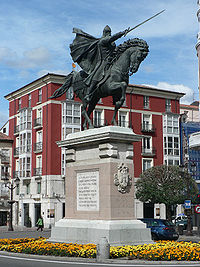 The statue of El Cid.
The statue of El Cid.
 The cathedral Our Lady of Burgos.
The cathedral Our Lady of Burgos.
Main sights
Burgos is rich in ancient churches and convents. The three most notable are the cathedral, with its chapel of the Condestables de Castilla, the monastery of Las Huelgas, and the Carthusian monastery of Miraflores. Minor notable churches are San Esteban, San Gil (Sancti Aegidii), San Pedro, San Cosme y San Damián, Santiago (Sancti Jacobi), San Lorenzo and San Lesmes (Adelelmi). The Convento de la Merced, occupied by the Jesuits, and the Hospital del Rey are also of historic and architectural interest.
Among the other interesting architectural structures, in the walls of the city are the famous gateway of Santa María, erected for the first entrance of the Emperor Charles V, and the arch of Fernán González.
Gothic Cathedral
Main article: Burgos CathedralOn the Gothic Cathedral at Burgos, begun in 1221, construction spanned mainly from the 13th to 15th centuries. It has been declared a UNESCO World Heritage Site. The west front is flanked by towers terminating in octagonal spires covered with open stonework traceries. The middle section, which serves as an entrance, has three alabaster pilasters, the intercolumnar spaces bearing panel-pictures representing the martyrdom of saints. The façade possessed ornate and fantastic surface decoration.
The octagonal chapel of the Condestable, in florid, thus highly sculpted, Gothic design, has a roof finished with balustraded turrets, needle-pointed pinnacles, and statues. In the lower portion, coats of arms, shields, and crouching lions have been worked into the ensemble. The exterior of the sacristy is decorated with carved traceries, figures of angels and armoured knights. The elaborate tabernacle is composed of two octagonal sections in Corinthian style.
Monasterio de las Huelgas
Main article: Las HuelgasThe Monasterio de las Huelgas Reales (Monastery of the Royal Retreats) on the outskirts of the city, was founded in 1180 by king Alfonso VIII, and was begun in a pre-Gothic style, although almost every style has been introduced over many additions. The remarkable cloisters have been described as "unrivalled for beauty both of detail and design, and perhaps unsurpassed by anything in its age and style in any part of Europe" (1911 Encyclopædia Britannica). One cloister has semicircular arches with delicate and varied columns; the other has an ogival style of early Gothic. The interior of the church has enormous columns supporting its magnificent vault; the entrance is modern. This convent historically benefited from extraordinary privileges granted to its abbess by kings and popes.
Cartuja de Miraflores
The Carthusian monastery of Miraflores Charterhouse is situated about four kilometres from the historic city center. Among the treasures of the Charterhouse are the wooden statue of St. Bruno, the wooden choir stalls in the church and the mausoleum of King John II and of his wife, Isabella of Portugal, constructed of marble and with their alabaster recumbent effigies. Around the top frieze are statues of angels in miniature. The French soldiers in the War of Independence (1814) mutilated this beautiful work, cutting off some of the heads and carrying them away to France. King John II's daughters by his first wife, heiresses Catherine, Princess of Asturias, and Eleanor, Princess of Asturias, are also buried in the monastery.
Historic centre
The Museum of Human Evolution
The Museum of Human Evolution was inaugurated on July 13, 2010. Its foundation is based on the archeological site of Atapuerca located 20 km (12 mi) east of Burgos. The Atapuerca site has been designated a UNESCO World Heritage Site. It contains several caves, where fossils and stone tools of the earliest known Hominids in West Europe have been found. (see Atapuerca Mountains)
Transportation
Burgos Airport
Burgos has an airport located only 5 km (3.11 mi) from the city centre, with daily flights to Barcelona International Airport, and during spring and summer to Palma de Mallorca, and Paris Orly.
Railway
The city has a new international railway station, located at the north-east, connecting it with cities like Paris and Lisbon.
The station also has connections with most cities of Spain, such us Madrid, Barcelona, Zaragoza, Salamanca or Bilbao.
In 2015, AVE high speed trains will serve the city, connecting it to cities like Madrid in only 84 minutes, or Bilbao in 70 minutes.
Bus
Burgos has an international bus station located in the city centre, just a hundred of meters from the Cathedral. It connects the city with nearly every region of Spain, and also with a wide number of European cities.
Bicycle
The city has its own free public bicycle rental system, called Bicibur. It has been designed by a local company, and has more than 20 points of distribution throughout the city.
Sustainable mobility
Burgos has undertaken many efforts concerning sustainable mobility, and it won the CiViTAs City of the Year in 2007, the most important Award at the European level and the Energy Globe Award in 2008 (the sustainability Nobel awards) in the Air Category for the same reason. The city is the leader among Spanish cities in terms of sustainable mobility with big efforts for a city centre free of cars, a free bicycle loan system and 100% clean public transport. Burgos now leads the CiViNET Network of cities concerned with sustainable mobility in Spain and Portugal.
Cityscape
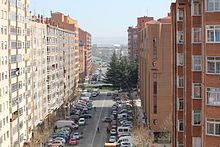 Urbanisation in the Gamonal district
Urbanisation in the Gamonal district Burgos city view facing south east
Burgos city view facing south east
Burgos city view facing south east Parks and Recreation
- Fuentes Blancas is Burgos' most visited large park extending east from the city along the river Arlanzón. It contains a network of walking and biking paths and includes camping and various outdoor recreational activities.
- Paseo del Espolón is the tree-lined promenade that is the most emblematic of Burgos. It's situated along the banks of the river Arlanzón, and consists of a landscaped walk that goes from the theater square to the Arc de Santa Maria, passing shops and cafes. It's a popular social spot for residents during the warm summer months.
- Paseo de la Isla is another one of Burgos' beautiful tree-lined garden walks. It passes by the Palacio de la Isla, Franco's headquarters during the Spanish Civil War
- Parque El Parral is located at the old "Hospital del Rey", a former hospital for pilgrims of the "Way of Saint James", now part of the University of Burgos campus
Economy
Culture
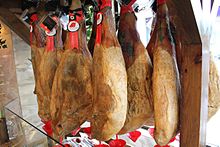 Jamón Serrano - Dry-cured Spanish Ham
Jamón Serrano - Dry-cured Spanish Ham
Cuisine
Burgos province is famous for Queso de Burgos, a white cheese which is soft and unctuous (because it is made with whey). Although originally made with sheep's milk, now cow's milk or mixtures are more common. Each comarca (rural district) produces a minor variation, and the major dairies produce an industrial product that is acceptable for people with sensitive digestion (it is said to promote good health if taken every day)
Burgos is blessed with a moderate climate and this fresh cheese was possible to conserve there without the need for curing for more than 10 days. With the improvement of aseptic industrial production processes this can be been extended to about 30 days at a cool 6 °C. Its production reaches 35,000 tons annually.
Morcilla de Burgos, a pig's-blood sausage, is a staple country food famous across the Iberian peninsula. Spiced with onions and herbs its most noticeable content is rice (often mistaken for fat) which makes it one of the lightest and healthiest products of its kind. Oral tradition says that it must be "salty, smooth and piquant". (see Spanish pages es:Burgos (desambiguación) for details)
Both products are regularly found all over Spain sliced and skewered on a slice of baguette bread as tapas (small bar-top treats, often served free with drinks).
Jamón Serrano (Literally: Mountain Ham): dry-cured Spanish Ham. Just as in most of Spain, this is a very popular food in Burgos. It is usually served in thin slices, eaten by itself or in a sandwich.
International relations
Twin towns — Sister cities
Burgos is twinned with:
 Bruges, Belgium
Bruges, Belgium Loudun, France
Loudun, France Pessac, France
Pessac, France San Juan de los Lagos, Mexico
San Juan de los Lagos, Mexico Valencia, Valencian Community, Spain
Valencia, Valencian Community, Spain Vicenza, Italy
Vicenza, Italy
The mayors of Bruges in Belgium's Flemish Region and Burgos signed a treaty on 29 January 2007 in Bruges's city hall for future cooperation. This engagement could be seen as a prologue on the opening of the exhibition Comeliness and Madness. This exhibition on Philip the Handsome took place in the Casa del Cordón in Burgos where the monarch died. On 30 January 2007, the exhibition opened in Bruges, the city where Philip the Handsome was born and where the urn with his heart is kept in Onthaalkerk O.L.V. (the Church of Our Lady).
Burgos and San Juan de los Lagos sponsor and coordinate activities between both populations.
Gallery
-
Burgos Cathedral,
(south side) -
Palacio de La Isla - Franco's headquarters during the Spanish Civil War
See also
- Burgos Airport
- University of Burgos
- Burgos CF, the city's football team.
- List of municipalities in Burgos
- Province of Burgos
Notes
- ^ Teofilo F. Ruiz, "The Transformation of the Castilian Municipalities: The Case of Burgos 1248–1350" Past and Present 77 (November 1977, pp. 3–32), p. 5.
- ^ Wright, Joseph, 1892, A Primer of the Gothic Language, glossary & section 182.
- ^ It later became the Kingdom of Castile, being sometimes united with Navarre and sometimes with Leon. In the reign of St. Ferdinand III (c. 1200–1252), Leon and Castile were united, but they continued to be called respectively the Kingdom of Leon and the Kingdom of Castile until the nineteenth century.
- ^ The Camino de Santiago passed directly through the city, where an urban section of it was called the "French Road" (Ruiz 1977:13).
- ^ Ruiz 1977:10.
- ^ Ruiz 1977:6-9.
- ^ Ruis 1977:23.
- ^ "Valores Climatológicos Normales. Burgos / B. Aérea". Agencia Estatal de Meteorología. http://www.aemet.es/es/elclima/datosclimatologicos/valoresclimatologicos?l=2331&k=cle. Retrieved 2009-10-17.
Sources and external links
 This article incorporates text from a publication now in the public domain: Herbermann, Charles, ed (1913). "Burgos". Catholic Encyclopedia. Robert Appleton Company.
This article incorporates text from a publication now in the public domain: Herbermann, Charles, ed (1913). "Burgos". Catholic Encyclopedia. Robert Appleton Company.- Camino de Santiago
- Museum of Human Evolution
- Ayuntamiento de Burgos
- Burgos Chamber of Commerce
- University of Burgos
- Burgos news
- Museo Militar de Burgos
- Photos of Burgos
Capitals of provinces of Spain - A Coruña
- Albacete
- Alicante
- Almería
- Ávila
- Badajoz
- Barcelona
- Bilbao
- Burgos
- Cáceres
- Cádiz
- Castellón de la Plana
- Ciudad Real
- Córdoba
- Cuenca
- Donostia-San Sebastián
- Girona
- Granada
- Guadalajara
- Huelva
- Huesca
- Jaén
- Logroño
- Las Palmas de Gran Canaria
- León
- Lleida
- Lugo
- Madrid
- Málaga
- Murcia
- Ourense
- Oviedo
- Palencia
- Palma
- Pamplona
- Pontevedra
- Salamanca
- Santander
- Santa Cruz
- Segovia
- Seville
- Soria
- Tarragona
- Teruel
- Toledo
- Valencia
- Valladolid
- Vitoria-Gasteiz
- Zamora
- Zaragoza
 Categories:
Categories:- Burgos Province
- Municipalities in Burgos
- Tourism in Spain
- Populated places in Burgos
- Burgos
Wikimedia Foundation. 2010.

